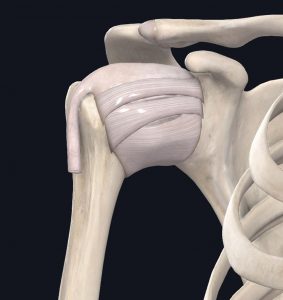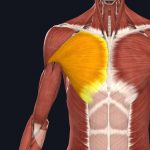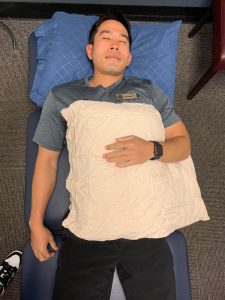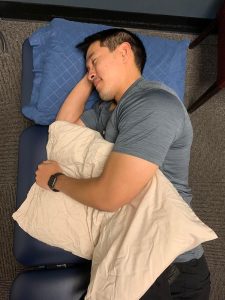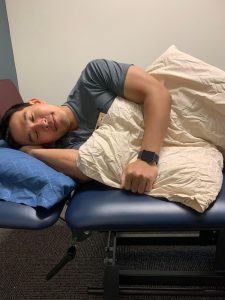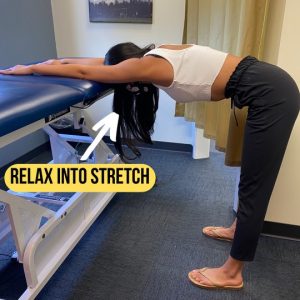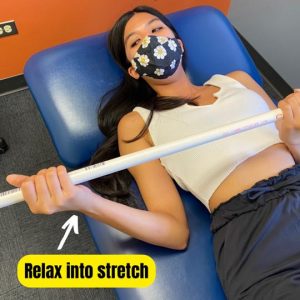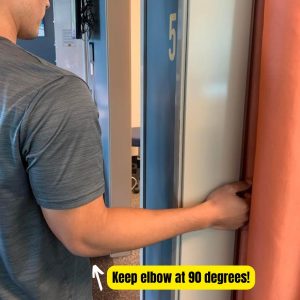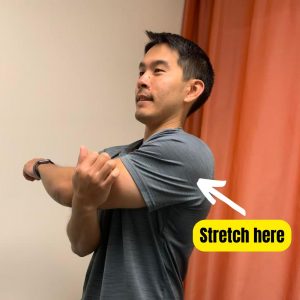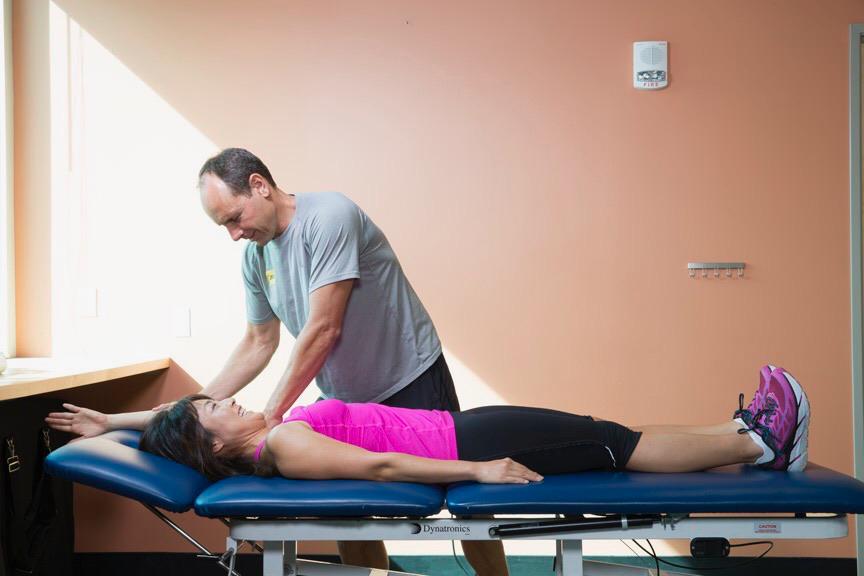
If you’ve recently visited the doctor for shoulder discomfort and left with a diagnosis of “adhesive capsulitis” or “frozen shoulder,” you should know the dos and don’t of frozen shoulder management!
Frozen shoulder may seem like a scary diagnosis, but it’s actually very common and manageable.
Yes, your shoulder is painful and stiff, we hear you! The good news is that it is curable, as long as you seek proper care. With the right treatment, your shoulder should start feeling and moving better over time.
Over time. Full recovery can take a while (in some gnarly cases, up to 2 years). You’ll need to be patient with your body. Forcing the shoulder to do things that it cannot could delay healing or injure it further.
Before we get into the dos and don’ts of managing your frozen shoulder, you should understand its background a bit more. If you better understand your diagnosis, you’ll better understand the treatment approach.
Need some more guidance? Book a physical therapy session session at one of our Oahu locations!
What is a Frozen Shoulder?
Frozen shoulder is often interchangeable with its more technical term adhesive capsulitis. The term refers to how it sounds: the ligamentous capsule that provides structural support to the shoulder joint becomes adhered to itself, essentially “freezing” the movement of the shoulder.
Sometimes a frozen shoulder is used loosely to describe a tightened capsule around the shoulder joint, but the specific diagnosis refers to the full adhering of the capsule which can be a painful and limiting condition.
- The Capsule’s Glenohumeral Ligaments
Images courtesy of Complete Anatomy
Presentation of a frozen shoulder includes loss of range of motion and pain when you move your arm. You will feel a lot more limited doing daily activities that involve reaching up or around your body, such as itching your back, putting on a seatbelt, wiping, and fastening a bra strap.
Typically, you will gradually lose more motion, but it can eventually resolve itself. It can take over a year to recover without treatment. Treatment could expedite the process.
Frozen Shoulder Stages
A true frozen shoulder will consist of three phases:
- Freezing phase (painful): This is the phase when the shoulder starts to become more painful and gradually lose range of motion. It is particularly painful at night and when you lie down. This phase can last between 2 to 6 weeks, or longer if you are diabetic.
- Frozen phase (stiffening): This is the phase when the pain stops, but stiffness persists. You will typically sleep better at night compared to the first phase. This phase can last roughly around 2-6 months.
- Thawing phase: This is the phase that your shoulder’s motion returns to normal. This phase can take about 6 months to 2 years.
Most people start noticing their symptoms in the freezing to frozen stages because of the pain and stiffness limiting function. If you’re noticing symptoms, don’t wait until it affects your rest during the frozen phase to get treatment.
Treatment Options
If you’ve been diagnosed with a frozen shoulder, what’re the treatment options, and what’s the best route for you?
Physical Therapy to Conservatively Treat Frozen Shoulder
Physical therapy can get the ball rolling! Your physical therapist can gently stretch out your tight shoulder with the appropriate techniques and provide you with the exercises and instructions to address the pain and stiffness.
Less Conservative Procedures
If your shoulder is being a bit stubborn, your doctor may administer a corticosteroid shot to stunt inflammation and decrease pain with everyday activities.
But, if the progress is falling behind schedule, your doctor may determine that you’re a candidate for a procedure that may speed things along.
Manipulation Under Anesthesia
During this procedure, you will be put to sleep and the surgeon will forcefully move your shoulder to stretch the tight capsule and scar tissues. This will help release the capsule and improve your shoulder range motion.
You won’t feel a thing, and many plateaued cases find relief from this procedure. But your work isn’t done – it’s not the cure! Physical therapy is prescribed the same or next day to help maintain the range of motion that was achieved from the surgery.
Surgery for Frozen Shoulder
For unrelenting cases, your doctor may decide to perform a shoulder arthroscopy to release the capsule. During this procedure, the surgeon will cut through the tight portions of the shoulder joint capsule with pencil-like equipment through small incisions around your shoulder.
Again, this is not the cure. You will still need to rehabilitate your shoulder, just as you would with any procedure. Without the proper care from a physical therapist, you could find yourself back at square one.
If your doctor determines that one of these procedures is required, you should deem it as an opportunity to gain ground in rehabilitation. Never stop rehabilitation after a procedure – you may risk losing ground.
So, how do you make sure you capitalize on your rehabilitation efforts for the quickest recovery possible? What should you avoid?
The Do’s and Don’ts of Frozen Shoulder Management
These are general suggestions on managing your recovery, but everyone is different.
If you have questions related to your unique recovery, you should always discuss it with your physical therapist.
We’ve got you covered! JACO Rehab knows how to get a frozen shoulder moving. Contact us for appointment availabilities.
Do: Massage Your Frozen Shoulder
Frozen shoulder is a deep joint issue, but it can feel like superficial pain. Don’t be afraid to massage the muscles around your shoulder for relief.
The capsule is the most affected area, but the muscles that surround the shoulder joint can become tight due to disuse. Some affected muscles include the pecs/chest, upper trapezius, and the deltoid.
- Pectoralis Major (pectoralis minor sits underneath)
- Lateral Deltoid
- Upper Trapezius
Images courtesy of Complete Anatomy
Don’t: Strengthen Those Muscles Too Early
Because the muscles that surround your shoulder joint will also tighten, you do not want to contribute to further tightness by strengthening them too early.
Your shoulder is likely still limited during early rehab stages, and involved musculature will not strengthen properly. Premature strengthening can lead to other injuries later.
Do: Learn How to Sleep with a Frozen Shoulder
Sleeping on the affected shoulder can be very painful and keep you up at night. You’ve probably found that out already! But there are ways to sleep with a frozen shoulder to minimize pain throughout the night.
Try to sleep on your back or on your opposite shoulder, and place a pillow under the armpit of the affected shoulder to prop it in a comfortable position.
You may not stay in that position throughout the night, but at least you’ll get a chance to fall asleep for some time. Rest is important for healing, decreasing inflammation, and improving your pain threshold.
Don’t: Force Your Shoulder to Do Painful Activities
This includes sleeping, which was already addressed above.
Do not perform repetitive motions of your shoulder or lift and carry objects overhead that are too heavy for your shoulder to handle. These actions can irritate your shoulder and cause more pain and discomfort.
Remember – your physical therapist will notice any regressions! We take measurements every visit to make sure you’re headed on the right track. If numbers are going backwards because of “overworking” the shoulder, that’s not a good sign.
Do: Perform Frozen Shoulder Exercises as Prescribed
Stretching the shoulder as prescribed by your physical therapist will help increase your mobility. Here are three examples of frozen shoulder exercises that you can start to help stretch the capsule and reduce some of the pain and discomfort.
Table Shoulder Flexion Stretch
The purpose of this exercise is to increase shoulder shoulder flexion range of motion, which will help you get back to activities that involve lifting your arm into an overhead position. All you need is a table or counter top that is about waist height. Keep your shoulders down and take steps back to get a stretch in your shoulder.
Shoulder External Rotation Stretch (Using Dowel or Wall)
This exercise restores the shoulder’s external rotation, which can help with improving your posture, the ability to lift overhead, and the flexibility to reach behind your back. You can perform this exercise lying down with a stick or standing up near a wall.
- With Dowel
- With Wall
Cross-Arm Shoulder Stretch
The purpose of this exercise is to stretch and relieve the tension in the back of your shoulder. Simply grab the elbow of the affected shoulder with your other hand and pull the arm across your body. You should feel a stretch in the back of your shoulder.
It is important to hold these stretches for about 30 secs in order to fully stretch out the restricted capsule. You want to stretch up to a point where you feel some tension in your shoulder. If you feel an increase in sharp pain or if the pain lingers for more than 5 minutes after you stretch, you might be pushing the stretch too far.
Don’t: Stop Physical Therapy Prematurely
Unless you aren’t able to attend therapy for financial or logistical reasons, you should not stop going. If you must stop, tell your therapist in advance so they can draw up a home exercise plan for you to continue at home.
Stopping treatment too early could be detrimental to your function later. You may not obtain the full range of motion… and strength… that your shoulder previously had.
Gently stretching the shoulder takes time, but your work isn’t done there.
Flexibility and strength are important to function. Once your shoulder starts to feel more flexible, you will want to begin a strengthening program. This doesn’t usually happen until later in your treatment regimen.
Since the shoulder has not been used as much due to stiffness and pain, its surrounding muscles will be weak. Returning to previous activities that involve lifting, reaching, and carrying too quickly can overload weak muscles and create pain and inflammation.
In order to prevent the recurrence of stiffness or a tendon injury, you’ll need to take it slow. Your therapist can prescribe the appropriate exercises that can help get you back to your full potential.
You will want to continue some physical therapy exercises for maintenance after you discharge. In fact, you may want to do them on BOTH sides. Once you get a frozen shoulder on one side, you have a higher chance of getting it on the other.
How do you keep that from happening?
How to Prevent Frozen Shoulder
The exact cause of a frozen shoulder is still unknown, but it is a common diagnosis. Research hasn’t figured it out quite yet.
Science does know that it occurs in those with diabetes or a recent history of shoulder surgery/injury that resulted in immobilization (like a sling). Most cases of frozen shoulder happen between the ages of 40-60, mostly women. And, for some reason, there is a high occurrence in those of Asian descent.
Although you can’t control all of these risk factors, you can control a few. By staying in good health, maintaining decent flexibility/strength, and decreasing inflammatory levels, you can help prevent a frozen shoulder.
Reach Out!
Need help treating a painful, stiff shoulder? JACO Rehab can help. Don’t wait until it becomes unbearable, reach out!
Written by Joey Torigoe, DPT
